By Lambert Strether of Corrente.
“Change and decay in all around I see.” –Henry Francis Lyte, Abide with Me
Utah’s Great Salt Lake is drying up. A resident mourns what was:
That used to be full of water. My wife asked if a piece of metal was a wheel chair ramp…nope, the old dock.
Next a view from the visitor’s center. The causeway in the distance had water up to the edge when I was in HS. pic.twitter.com/IkYisSUZg2
— Michael Kofoed (@mikekofoed) July 29, 2022
Reading @mikekofoed thread, I naturally wondered what the status of “land artist” Robert Smithson’s iconic “Spiral Jetty,”[1] which (when created) jutted into the Great Salt Lake. How it started, very beautiful:
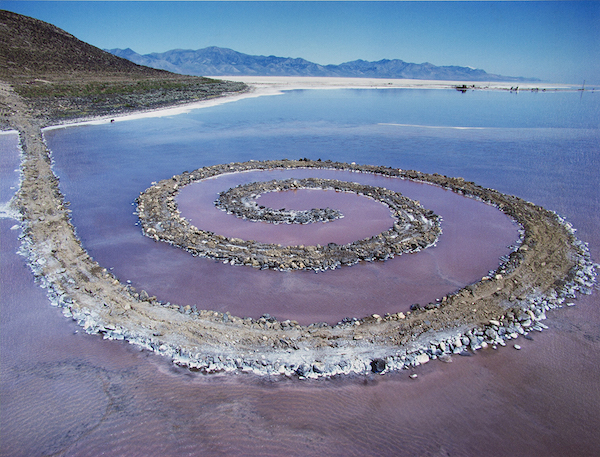
(Smithson is said to have selected the site for the red color, seen here.) How it’s going, also very beautiful:
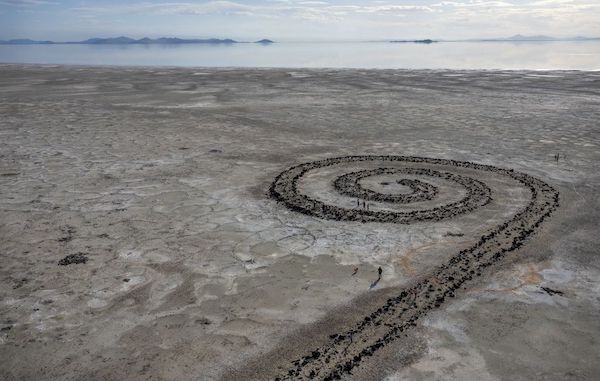
Still beautiful, but a jetty without water. The Salt Lake Tribune raises a classic question in aesthetics: “Spiral Jetty: A barometer for the Great Salt Lake, or a work of art unto itself?”
Like any work of art, the value of Spiral Jetty — easily the most recognizable artwork in Utah — depends on how you look at it.
Jaimi Butler, the coordinator of Westminster College’s Great Salt Lake Institute, called the 1,500-foot rock formation artist Robert Smithson created in 1970 an “artistic water gauge” of the Great Salt Lake….
The jetty “is a barometer for the ways in which we are operating in a climate emergency,” said Lisa Le Feuvre, the head of the Holt/Smithson Foundation, which oversees the creative legacies of Smithson and his wife, Nancy Holt.
Smithson never intended Spiral Jetty to be a barometer of anything, said Hikmet Sidney Loe, a former professor at Westminster College who wrote “The Spiral Jetty Encyclo” (University of Utah Press, 2017), a comprehensive book about Smithson and his most famous work.
“He wanted a very dynamic environment, so the salt crystals would form, dissipate, the colors would change and the water would rise and fall,” Loe said. “But he wasn’t [thinking], ‘In 50 years, here’s what people are going to think about my work.’”
The classicist’s dulce (sweet) vs. utile (useful) dichotomy (but why not both? “It’s a dessert topping! It’s a floor wax!”). However, confronting Smithson’s vast body of work, I find I don’t have a coherent aesthetic I can use to give an account of them, so I won’t go further with theory. (I have a few claims I make about art, but that’s not the same as having a theory). I will also shirk my responsibilities by not giving even a potted biography of Smithson, a summary of his writings (autodidactic; very 60s; prolix; less interesting than the art. Here’s an example). Nor will I expound upon the concept of entropy — “things fall apart” will do — or explicitly relate the concept to Smithson’s art. But you’ll know it when you see it:
If anyone is working on Robert Smithson and needs an image to illustrate the entropic principle I can probably help pic.twitter.com/EBGqzFz9tM
— Jeremy Millar (@jeremy_millar_1) May 18, 2022
Sadly, then, this post will not be a critique or even an appreciation. Rather, I will present a series of Smithson’s works — or, rather, images of Smithson’s works — first some minor ones, and then three major ones: “Spiral Jetty” itself, then “Partially Buried Workshed,” and finally “Amarillo Ramp.” My and your remarks will then accrete round the armature of the works. In more or less chronological order, “Heap” being early, and “Ramp” being late, indeed final:
“Heap of Language”:
robert smithson, a heap of language pic.twitter.com/QyPO8Jjjw2
— wordvoid (@wordvoid) July 28, 2022
Like a heap of sand, one more grain will trigger an avalanche. Bloggers know this feeling.
“Glue Pour”:
ROBERT SMITHSON
Glue Pour, 1969large drum of glue, industrially produced by National Starch and Chemical Company poured over a hill pic.twitter.com/6IkPJFtOWS
— Yempejji Culture Channels (@yempejji) February 3, 2022
Here is the view of a Canadian art critic:
When the drum delivered by National Starch and Chemical Company was pried open, its sticky contents were a garish orange—not the expected neutral grey. Buoyed by the convivial mood of his co-conspirators, master of ceremonies Robert Smithson proceeded to lower the barrel into position atop the steeply inclined clay bank near the University of British Columbia campus, a site scouted by Vancouver artist and accomplice Christos Dikeakos.
Dikeakos’s grainy documentation of Smithson’s Glue Pour (1970) captures the prehistoric drama of the event. The adhesive slime, released from its plastic liner, conjured the manufactured terrors, and unintended comedy, of a science-fiction movie. “At the commencement of the pour everyone laughed or had a smile on their face,” recalls Dikeakos. Yet it was only in retrospect that Smithson’s simulated magma flow evoked, for some, a sexually charged travesty of Modernist painting’s theatrics (picture a cross between the poured canvases of Helen Frankenthaler or Morris Louis and a stag film).
Or perhaps The Blob? (Although it’s hard to imagine conviviality among those Present at the Creation it’s not, I suppose, impossible.)
“Line of Wreckage, Bayonne, New Jersey”:
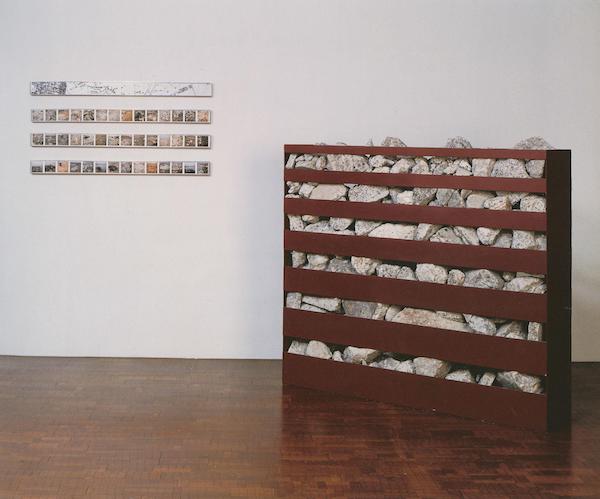
I love the museum label: “Painted aluminum container with broken concrete, framed map, and photo panels.”
The Holt Smithson Foundation[2] describes the work:
Broken pieces of concrete gathered from a destroyed New Jersey highway are arranged inside a steel box with horizontal openings, alongside a map and a series of photographs on the wall providing geographic and visual context. Smithson illuminates the forgotten, displaying post-industrial rubble as if it were an ancient ruin. The result is both anticlimactic and tragic. Visually mundane, the site is afforded our attention within the gallery setting—and its material remains demand a reckoning with the pervasion of loss in an otherwise invisible place.
And the theory behind the work:
The Nonsite (an indoor earthwork) is a three dimensional logical picture that is abstract, yet it represents an actual site in N.J. (The Pine Barrens Plains). It is by this three dimensional metaphor that one site can represent another site which does not resemble it—thus The Nonsite. To understand this language of sites is to appreciate the metaphor between the syntactical construct and the complex of ideas, letting the former function as a three dimensional picture which doesn’t look like a picture.
As a photographer, I have to give this some thought. After all, one photographs at a site. And if the photo is hung, it can only be at a nonsite.[3]
Now let’s turn to some of Smithson’s major works. First, “Spiral Jetty” itself. Although we discussed the dematerialization of the substance in which the jetty was immersed, we never discussed the materiality of the jetty itself, 6,650 tons of sand, earth, and rock (primarily black basalt), delivered and positioned by two dump trucks, a tractor, and a front-end loaded. Here is a long thread on that topic:
Let’s begin with the sand. It’s difficult to see from the photo but this sand is special. The grains at the Great Salt Lake are ooilitic, meaning they are well rounded grains. This leads to a slippery walk where they are dry and you sink into the sand further than “normal” sand pic.twitter.com/m0P7iTFC0J
— Carly Lee (@_Sackung) December 6, 2020
“Partially Buried Woodshed,” at Kent State University in Ohio:
Here is a thread showing the construction:
Robert Smithson, Partially Buried Wood Shed, 1970 pic.twitter.com/C37AXeXNVu
— Yempejji Culture Channels (@yempejji) June 11, 2022
(Earth was loaded onto the roof of the woodshed until the center beam cracked.) And here we see the post-Kent State University Massacre graffiti:
Robert Smithson, ‘Partially Buried Woodshed’ (1970) pic.twitter.com/0EOGNbKEo3
— Jeremy Millar (@jeremy_millar_1) May 4, 2021
Hilariously, however, the real forces of entropy at work were not the massacre, nor the slow rotting and ultimate collapse of the shed, but — just let me position my knee here so it doesn’t impact anything — the university administrators:
[Smithson] valued the work at $10,000 and donated it to the university, asking that no changes be made and that the structure be allowed to deteriorate naturally. Shortly after the May 4, 1970, Kent State shootings, an anonymous person added the inscription ‘MAY 4 KENT 70’ with white paint to one of the structure’s horizontal beams.[4] The addition of the message about May 4, 1970 helped make the Partially Buried Woodshed one of the many memorial sites on campus.[2]
The work was set on fire by an unknown arsonist on March 28, 1975, burning much of the left side and causing the structure’s major collapse.[5] The University Arts Commission recommended in April that the roof and burned portion be removed [as opposed to being repaired]—mostly citing safety concerns—with the remaining walls, earthen mound, and rafters allowed to continue the natural aging process.[6] By late April, the university had much of the damaged section removed and planned to landscape the area around the sculpture as a park.[7] Smithson’s widow, Nancy Holt, visited the work on May 3, 1975, and called for its preservation.[8] A committee recommended in June 1975 that the entire sculpture be removed, citing liability concerns, though university president Glenn Olds ultimately decided to keep the remains of the sculpture in 1976. Sometime in mid-1981, the center beam fully broke, and in January 1984, the remaining wooden elements of the structure were quietly removed by the university.[9] While the School of Art hosted exhibits in 1990 for the 20th anniversary of the work’s creation, and again in 2005 for the 35th anniversary, the location of the artwork was largely ignored until Kent State University added an informational plaque to a sidewalk near the site in 2016.[10]
Finally, “Amarillo Ramp”:
Here is the initial sketch for the project:
July 1973. Robert Smithson begins work on a new project “Amarillo Ramp.” #landart #art pic.twitter.com/L95CEymYvh
— Troublemakers (@landartfilm) July 16, 2015
Here is Amarillo ramp then, as constructed:
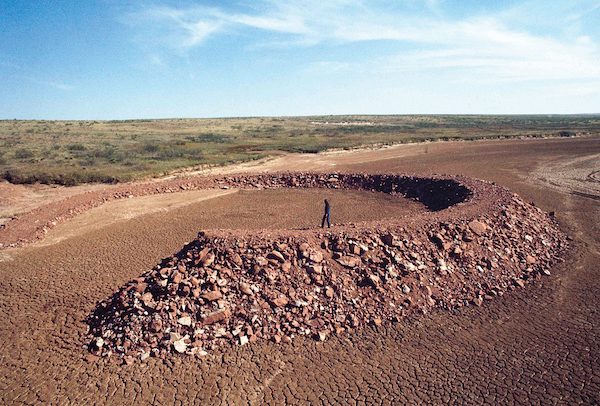
And here is Amarillo ramp now, having decayed:
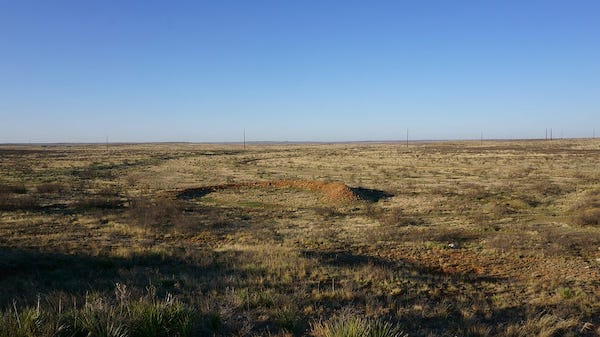
If you want to see this one, you’d better hurry up. From Texas Highways:
In 1973, when it was completed, Amarillo Ramp was a spiral pathway jutting into Tecovas Lake, an artificial body of water outside of Amarillo. It was comprised of sandstone found in the area, compacted to an ascending height of 15 feet, and measured 140 feet in diameter. Now, with the lake long since dried up, Amarillo Ramp amounts to a quirky, failing rock formation.
Stanley Marsh 3, an Amarillo arts patron, commissioned Amarillo Ramp for his vast property around the same time he enlisted the art collective Ant Farm to create the more well-known Cadillac Ranch off historic Route 66. Smithson died before the completion of Amarillo Ramp, but his widow and artistic partner, Nancy Holt, along with artist friend Richard Serra, came to the rescue and executed the project. They added but one final touch to Smithson’s design: They cast the sides of the ramp at a slight angle rather than at 90 degrees.
Make arrangements to view Amarillo Ramp by emailing the Holt/Smithson Foundation, which is dedicated to the legacies of the married artists, at ar@holtsmithsonfoundation.org. This rarely seen work comes with a personal tour guide and requires a 15-minute drive down a gravel road. What awaits on private land is a sliver of its original self and could easily be lost in the camouflage of the landscape. But it’s there, reminding us, in the service of dying, to live life before we too are just dust in the wind.
What Texas Highways doesn’t say is that Smithson had gone up in a small plane[4] to inspect the site, and he and his pilot died in a crash. Here’s the crash report:
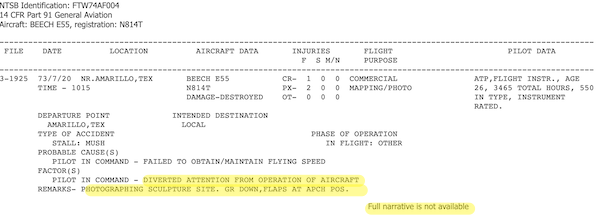
It’s interesting to think that earth from the Ramp, plus the crash report, would constitute a nonsite. (The note that “Full narrative is not complete” is so post-modern I can’t stand it.)
One critique of Smithson’s work is that it is not “political,” which art should be. In vulgar form:
the point of art is for it to Do Politics, so you can look at it and go “wow politics” and “if only other people were as enlightened as me, to see these politics”
— let le wokisme win (@lyta_gold) July 30, 2022
Or, in more sophisticated form, from “Ecological Art: What Do We Do Now?” at, amazingly enough, Nonsite.org:
[Araeen’s’] critique of the unseeing egoism of American earth artists such as Smithson and Morris is not without precedent. What is unusual about his manifesto is its optimism despite ecological warning signs, many of which we are alerted to by artists. While Araeen rails against ego in the realm of art that focuses on nature, he claims that the idea of making land into art in significant ways remains potent. How? Through what he calls “collective work” (683), a radical transformation of human consciousness. He cites Beuys’ famous 7000 Oaks project – begun at Documenta 7 in 1982 and continued in New York – as an example of how to make planting trees “part of people’s everyday life” (682).
As NC readers know, the Earth’s requirement is not trees, but forests. More:
Many contemporary artists share Araeen’s sense of urgency. They agree that fellow artists should focus on ecological issues but also caution that this emphasis is not yet sufficiently global. Araeen’s examples of art’s ameliorative effects center on bringing water issues – specifically more widespread desalination — to the fore… Basia Irland has similarly underlined the potency of social organization and participation in her many “Gathering” works. A Gathering of Waters; Rio Grande, Source to Sea,” she reports for example, started in 1995 and “took five years to complete.
[UPDATE I am having a highly irritable reaction to Irland here, brought on by Nonsite’s framing, more than Irland’s projects themselves.] This reminds me of one of those horrid listening sessions where a consultant posts sticky notes of the attendee’s suggestions (and doubtless throws them away, having already written their report, or recycled it from another project. Forgive my cynicism.) More:
Connections were made that have been lasting, and groups are working together that never would have met otherwise. In order to participate in this project, you had to physically be at the river and interact with someone else downstream, thereby forming a kind of human river that brings awareness to the plight of this stream that is always asked to give more than it has.”
Aesthetically, I think this is hooey, and NGO-style hooey at that. I think Irland’s projects are primarily aestheticized documentation, as opposed to Capital A Art. (Implicitly my incoherent aesthetic says that art should last far beyond the milieu in which it was created, unlike, say, entertainment, socializing, or sticky notes. Objects have their own integrity that persists over historical time, regardless of whatever political use can be made of them.)
I’m sure I don’t need to further underline the themes of decay and entropy in Smithson’s work. He is, after all, deeply concerned with the material, which decays. That’s one aspect of his work that makes him the artist for the Jackpot. But there is a second, more subtle aspect of his work, and in a classic illustration of the post’s theme, I have misplaced and cannot recover the tweet that documents it. If I had the tweet, it would go in a blockquote. It’s a note to the Holt-Smithson foundation:
To Whom It May Concern:
Some kind but thoughtless students of mine recently visited “Spiral Jetty,” and brought back a gift for me: A rock they had taken from it.
Enclosed please find the rock. I am returning the rock to you, in the hopes that you can return it to the Jetty.
(There was a photograph of the box the rock came in, and the note.) In this way, Spiral Jetty, as art, was able to link unexpectedly the past and the future, in this case through acts of kindness (misplaced and, er, to be placed). We will need to be able to do this during the Jackpot just as much as we will need to be able to recognize (and mourn, and cope with) decay. The Forest Service (!!) quotes Smithson:
Nature does not proceed in a straight line, it is rather a sprawling development.
~Robert Smithson #quotes pic.twitter.com/fNatiR0gvW— Northern Research (@usfs_nrs) November 20, 2019
And, as a lemma, Nature does not proceed in a straight line down.
NOTES
[1] Nobody seems to remark on the surrealist aspect of “Spiral Jetty.” A spiral jetty is just as useful as Man Ray’s “Cadeau,” an iron with nails in the sole plate:
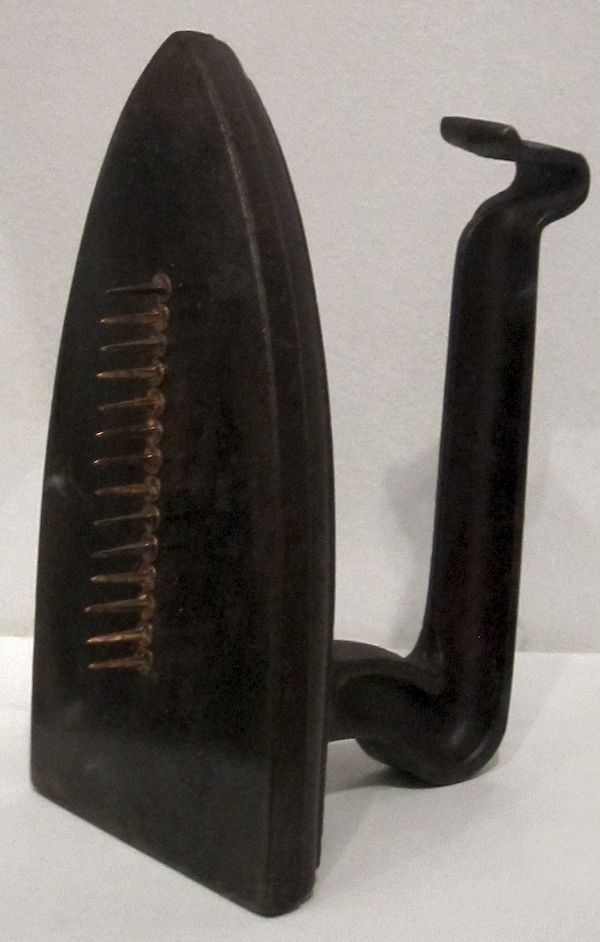
[2] I looked at the Holt-Smithson Foundation’s Board of Directors and didn’t see anything horrifying by NGO standards, as one might in other contexts.
[3] So as I can determine, there is no connection between Smithson’s concept of a nonsite, and Nonsite,org, edited by, among others, the redoubtable Adloph Reed.
[4] Unlike, say, Jackson Pollock; see link in note [2]. This is a joke.


